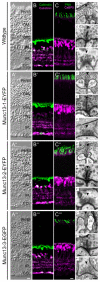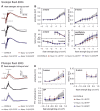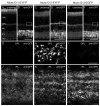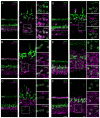Heterogeneous Presynaptic Distribution of Munc13 Isoforms at Retinal Synapses and Identification of an Unconventional Bipolar Cell Type with Dual Expression of Munc13 Isoforms: A Study Using Munc13-EXFP Knock-in Mice
- PMID: 33105896
- PMCID: PMC7660176
- DOI: 10.3390/ijms21217848
Heterogeneous Presynaptic Distribution of Munc13 Isoforms at Retinal Synapses and Identification of an Unconventional Bipolar Cell Type with Dual Expression of Munc13 Isoforms: A Study Using Munc13-EXFP Knock-in Mice
Abstract
Munc13 isoforms are constituents of the presynaptic compartment of chemical synapses, where they govern important steps in preparing synaptic vesicles for exocytosis. The role of Munc13-1, -2 and -3 is well documented in brain neurons, but less is known about their function and distribution among the neurons of the retina and their conventional and ribbon-type chemical synapses. Here, we examined the retinae of Munc13-1-, -2-, and -3-EXFP knock-in (KI) mice with a combination of immunocytochemistry, physiology, and electron microscopy. We show that knock-in of Munc13-EXFP fusion proteins did not affect overall retinal anatomy or synapse structure, but slightly affected synaptic transmission. By labeling Munc13-EXFP KI retinae with specific antibodies against Munc13-1, -2 and -3, we found that unlike in the brain, most retinal synapses seem to operate with a single Munc13 isoform. A surprising exception to this rule was type 6 ON bipolar cells, which expressed two Munc13 isoforms in their synaptic terminals, ubMunc13-2 and Munc13-3. The results of this study provide an important basis for future studies on the contribution of Munc13 isoforms in visual signal processing in the mammalian retina.
Keywords: Munc13-1; Munc13-3; brMunc13-2; conventional synapse; retina; ribbon synapse; type 6 ON bipolar cell; ubMunc13-2.
Conflict of interest statement
The authors declare no conflict of interest.
Figures







Similar articles
-
Munc13-independent vesicle priming at mouse photoreceptor ribbon synapses.J Neurosci. 2012 Jun 6;32(23):8040-52. doi: 10.1523/JNEUROSCI.4240-11.2012. J Neurosci. 2012. PMID: 22674279 Free PMC article.
-
Differential distribution of vesicle associated membrane protein isoforms in the mouse retina.Mol Vis. 2003 Dec 11;9:673-88. Mol Vis. 2003. PMID: 14685145
-
The Munc13 proteins differentially regulate readily releasable pool dynamics and calcium-dependent recovery at a central synapse.J Neurosci. 2013 May 8;33(19):8336-51. doi: 10.1523/JNEUROSCI.5128-12.2013. J Neurosci. 2013. PMID: 23658173 Free PMC article.
-
Synaptic transmission at retinal ribbon synapses.Prog Retin Eye Res. 2005 Nov;24(6):682-720. doi: 10.1016/j.preteyeres.2005.04.002. Prog Retin Eye Res. 2005. PMID: 16027025 Free PMC article. Review.
-
The making of synaptic ribbons: how they are built and what they do.Neuroscientist. 2009 Dec;15(6):611-24. doi: 10.1177/1073858409340253. Neuroscientist. 2009. PMID: 19700740 Review.
Cited by
-
Development and maintenance of vision's first synapse.Dev Biol. 2021 Aug;476:218-239. doi: 10.1016/j.ydbio.2021.04.001. Epub 2021 Apr 10. Dev Biol. 2021. PMID: 33848537 Free PMC article. Review.
-
Cell Types and Synapses Expressing the SNARE Complex Regulating Proteins Complexin 1 and Complexin 2 in Mammalian Retina.Int J Mol Sci. 2021 Jul 29;22(15):8131. doi: 10.3390/ijms22158131. Int J Mol Sci. 2021. PMID: 34360929 Free PMC article.
-
Molecular Assembly and Structural Plasticity of Sensory Ribbon Synapses-A Presynaptic Perspective.Int J Mol Sci. 2020 Nov 19;21(22):8758. doi: 10.3390/ijms21228758. Int J Mol Sci. 2020. PMID: 33228215 Free PMC article. Review.
-
Presynaptic Proteins and Their Roles in Visual Processing by the Retina.Annu Rev Vis Sci. 2024 Sep;10(1):347-375. doi: 10.1146/annurev-vision-101322-111204. Epub 2024 Sep 2. Annu Rev Vis Sci. 2024. PMID: 38621251 Review.
References
-
- Kalla S., Stern M., Basu J., Varoqueaux F., Reim K., Rosenmund C., Ziv N.E., Brose N. Molecular dynamics of a presynaptic active zone protein studied in Munc13-1-enhanced yellow fluorescent protein knock-in mutant mice. J. Neurosci. 2006;26:13054–13066. doi: 10.1523/JNEUROSCI.4330-06.2006. - DOI - PMC - PubMed
MeSH terms
Substances
LinkOut - more resources
Full Text Sources
Molecular Biology Databases
Miscellaneous

